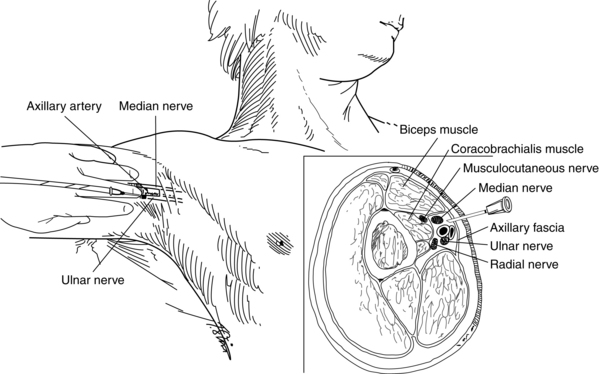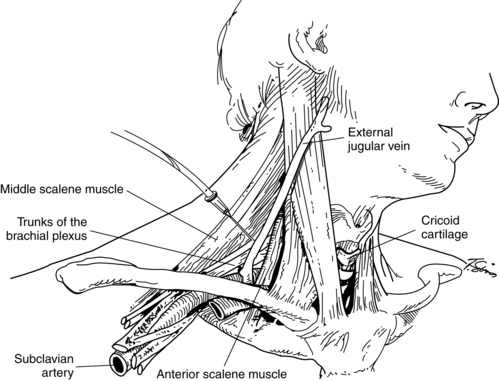Peripheral Nerve Blocks: Assisting with Insertion and Pain Management
Peripheral nerve blocks are administered as single local anesthetic injections or continuously through a catheter placed into a precise anatomic area to provide site-specific (e.g., femoral, brachial plexus, axillary, intrapleural, extrapleural, paravertebral, tibial, sciatic, and lumbar plexus) prolonged anesthesia or analgesia for postoperative and trauma pain management.7,33,34 The use of peripheral nerve blocks requires skilled and knowledgeable health care providers.7,33,34 Catheter placement and the continuing treatment of the patient should be under the direct supervision of an anesthesiologist, nurse anesthetist, or the acute pain service.22,33
PREREQUISITE NURSING KNOWLEDGE
• State boards of nursing may have detailed guidelines involving peripheral nerve blockade. Each institution that provides this therapy also has policies and guidelines pertaining to peripheral nerve blockade. It is important that the nurse is aware of state guidelines and institution policies.
• The nurse must have an understanding of the principles of aseptic technique.7,10,16,21,35 Peripheral nerve blocks are used as part of a preemptive and multimodal analgesic technique to provide safe and effective postoperative pain management with minimal side effects.8,10,12,15,19
• An understanding of the physiology of pain is essential. Pain is defined as an unpleasant sensory and emotional experience associated with actual or potential tissue damage or is described in terms of such damage.1,7,30
• Tissue trauma caused by surgery or injury initiates a series of biochemical events that release numerous endogenous chemicals that promote pain transmission, damage to body tissues, alterations in blood clotting, impaired immune function, and autonomic nervous system stimulation.1 The pathophysiologic effects of pain, such as delayed gastric emptying, development of ileus, and reductions in respiratory tidal volumes, may all predispose patients in pain to postoperative secondary infection.1,7
• No matter how successful or how deftly conducted, surgical operations produce tissue trauma and release potent mediators of inflammation and pain.23 Pain is just one response to trauma or surgery. Substances released from injured tissue evoke stress hormone responses in the patient. Such responses promote breakdown of body tissue; increase metabolic rate, blood clotting, and water retention; impair immune function; and trigger a fight-or-flight alarm reaction with autonomic features (e.g., rapid pulse) and negative emotions.1,7
• The patient in pain may attempt to “splint” the injured site, resulting in shallow breathing and cough suppression, followed by retained pulmonary secretions and pneumonia.3,9,11,16 Unrelieved pain also may delay the return of normal gastric and bowel function in the patient after surgery.3,5
• The basis for the efficacy and utility of peripheral nerve blockade in patients with acute pain is the interruption of nociceptive input at its source and through nociceptive transmissions in the peripheral nerve.7,21 In addition to blocking nociceptors in the incision, a continuous infusion may attenuate pain-mediating substances, such as histamine, bradykinin, and prostaglandins.23
• Peripheral nerve blocks with local anesthetics can be used to treat acute pain regionally in a number of ways. These vary from wound infiltration to continuous peripheral nerve blockade with the use of catheters that provide many hours or days of optimal analgesia after surgery or trauma.12,13,16
• Peripheral nerve blocks provide well-documented advantages in the postoperative period, including blunting of the surgical/trauma stress response, excellent analgesia, earlier extubation, less sedation, decreased incidence of pulmonary complications, reduction in blood loss, earlier return of bowel function, decreased deep venous thrombosis, earlier ambulation, earlier discharge from high-acuity units, and possibly shorter hospital stays.7,21,29
• Peripheral nerve blocks in the outpatient setting have facilitated early patient ambulation and discharge by decreasing side effects, such as drowsiness, nausea, and vomiting.3,9,11,15 In addition, unlike general anesthesia, peripheral nerve blocks do not alter the level of consciousness. By preserving the patient’s level of consciousness, the patient’s protective airway reflexes (e.g., cough and gag) are maintained and the need for airway manipulation and intubation is negated. Furthermore, with the use of peripheral nerve blockade, the complications of general anesthesia are avoided.3 Continuous peripheral nerve blockade improves postoperative analgesia, patient satisfaction, and rehabilitation compared with intravenous opioids for upper and lower extremity procedures.9,11,15,24,28
• The anatomic position of the specific catheter is clearly defined and documented after insertion (e.g., femoral, axillary [Figs. 103-1 and 103-2], brachial plexus [Fig. 103-3], intrapleural, extrapleural, paravertebral, tibial, sciatic, and lumbar plexus).4,29 Radiologic confirmation5 of the catheter position may be necessary to avoid suboptimal outcomes (e.g., pneumothorax). Catheters may be placed by the surgeon, anesthesiologist, or certified nurse anesthetist (CRNA) under direct vision, via ultrasound scan–guided techniques or with the use of a peripheral nerve stimulator, either adjacent to or directly into the nerve sheath (e.g., sciatic or tibial nerve during surgery for lower limb amputation).13,16,19–21,26,28 Catheters may also be placed after surgery (e.g., intercostals, intrapleural, axillary, brachial plexus, femoral, and paravertebral; Table 103-1).
Table 103-1
Single-Shot and Continuous Peripheral Nerve Blocks in the Critically Ill
| Block | Indications | Practical Problems |
| Interscalene | Shoulder/arm pain (e.g., shoulder dislocation/fractures, humeral fracture) | Horner’s syndrome may obscure neurologic assessment Block of ipsilateral phrenic nerve Close proximity to tracheostomy and jugular vein line sites |
| Cervical paravertebral (continuous catheter only) | Shoulder/elbow/wrist pain (e.g., shoulder fractures, humeral fracture, elbow fractures, wrist fractures) | Horner’s syndrome may obscure neurologic assessment Block of ipsilateral phrenic nerve Patient positioning |
| Infraclavicular | Arm/hand pain (e.g., elbow fractures, wrist fractures) | Pneumothorax risk Steep angle for catheter placement Interference with subclavian lines |
| Axillary | Arm/hand pain (e.g., elbow fractures, wrist fractures) | Arm positioning Catheter maintenance |
| Paravertebral | Unilateral chest or abdominal pain restricted to few dermatomes (e.g., rib fractures) | Patient positioning Stimulation success sometimes hard to visualize |
| Combination of femoral and sciatic block | Unilateral leg pain (e.g., femoral neck fracture [femoral], tibial and ankle fractures [sciatic])* | Patient positioning Interference of femoral nerve catheters with femoral lines |
*Caution: Compartment syndrome.
(Modified from Schulz-Stubner S: The critically ill patient and regional anesthesia, Curr Opin Anaesthesiol 19:538-544, 2006.)
• A three-in-one peripheral nerve block can be used for analgesia after proximal lower limb orthopedic surgery. A three-in-one peripheral nerve block provides analgesia to block three nerves, including the lateral femoral cutaneous, femoral, and obturator nerves.24 This block is as effective as epidural analgesia, with fewer side effects than epidural analgesia (e.g., urinary retention, nausea, and risk for epidural hemorrhage in patients with anticoagulation).5,6,13,




